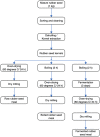Changes in anti-nutrient, phytochemical, and micronutrient contents of different processed rubber (Hevea brasiliensis) seed meals
- PMID: 34055479
- PMCID: PMC8140600
- DOI: 10.7717/peerj.11327
Changes in anti-nutrient, phytochemical, and micronutrient contents of different processed rubber (Hevea brasiliensis) seed meals
Abstract
Rubber (Hevea brasiliensis) is a perennial plant crop grown in many parts of Africa, South East Asia, and South America, especially within the hot and humid climatic regions. Rubber seed, either as feed or food, is a useful raw material to produce edible oil and protein. Despite the huge quantity of rubber seeds produced in Nigeria and its potential as a protein source, rubber seeds still appear neglected and under-utilised as feed/food given its perception as inedible and toxic due to the high concentration of cyanogenic glycoside. Therefore, the quest for effective processing technique(s) that would enhance its food use application is very fitting. This current study was directed to determine the changes in anti-nutrient, phytochemical, and micronutrient contents of different processed rubber seed meals. Specifically, the rubber seeds underwent processing, which employed boiling and the combined action of boiling and fermentation methods that brought about three seed meal flour groups, i.e., raw (RRSM), boiled (BRSM), and fermented (FRSM) seed meals. These were subsequently analysed for anti-nutrient/phytochemical (oxalate, phytate, tannin, phenols, saponin, hydrogen cyanide (HCN), alkaloids, flavonoids, and trypsin inhibitors), and micronutrient (which involved minerals (magnesium, phosphorus, calcium, iron, zinc, potassium, sodium, manganese, lead, and selenium) and vitamin (vitamin B1, B2, B3, C, E, and beta carotene)) contents. The results showed that the processing methods used to achieve the RRSM, BRSM, and FRSM, reduced the anti-nutrients (phytate, tannin, and oxalate) below the acceptable limits, and the HCN below the toxic levels. Importantly, the processing methods herein have not yet succeeded in removing HCN in the (processed) rubber seed meals, but can be seen to be heading toward the right direction. The FRSM obtained significantly lower (p < 0.05) anti-nutrient/phytochemical, but significantly higher (p < 0.05) mineral contents, compared with the other groups (RRSM and BRSM), except for flavonoids that obtained a 30% increase over the BRSM. Some mineral and vitamin contents could be lost in the BRSM compared to the others (RRSM and FRSM) in this study. Additionally, the FRSM obtained higher vitamin contents, after those of RRSM. Overall, the combined action of boiling and fermentation should be recommended for the proper utilisation of rubber seed as food/feed.
Keywords: Anti-nutrients; Boiling; Fermentation; Hevea brasiliensis; Minerals; Phytochemicals; Seed meals; Vitamins.
© 2021 Agbai et al.
Conflict of interest statement
Charles Odilichukwu R. Okpala is an Academic Editor of PeerJ.
Figures


References
-
- Abdoulaye C, Brouk K, Jie C. Phytic acid in cereal grains: structure, healthy or harmful ways to reduce phytic acid in cereal grains and their effects on nutritional quality. American Journal of Plant Nutrition and Fertilization Technology. 2011;1(1):1–22. doi: 10.3923/ajpnft.2011.1.22. - DOI
-
- Abdulhamid A, Ibrahim I, Warra AA. Estimation of some antinutritional factors in oil-free cake of egusi (Citrullus colocynthis L.) Journal of Food and Dairy Technology. 2014;2(1):9–11.
-
- Achikanu CC, Eze-steven P, Ude CM, Ugwokolie OC. Determination of the vitamin and mineral composition of common leafy vegetables in southeastern Nigeria. International Journal of Current Microbiology and Applied Sciences. 2013;2(11):347–353.
-
- Adetuyi FO, Ibrahim TA. Effect of fermentation time on the Phenolic, flavonoid, and vitamin C contents and antioxidant activities of Okra (Abelmoschus esculentus) seeds. Nigerian Food Journal. 2014;32(2):128–137. doi: 10.1016/S0189-7241(15)30128-4. - DOI
-
- Agbai CM, Olawuni IA, Azeke AE, Nwokenkwo EC, Alagbaoso SO. Evaluation of proximate and functional properties of rubber (Hevea brasiliensis) seed meals. African Journal of Food Science. 2020;14(11):407–413. doi: 10.5897/AJFS2020.2033. - DOI
LinkOut - more resources
Full Text Sources
Other Literature Sources

